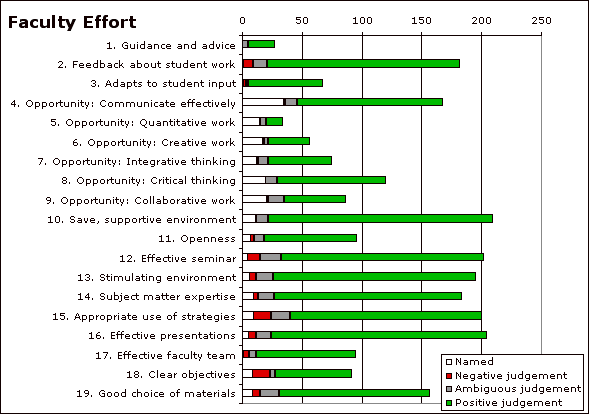Quantitative Reasoning for the Public Interest
Content Analysis of Student Evaluations of Faculty
We coded evaluations of faculty written by students during the 2003-4 academic year. Some were evaluations of 4 credit courses. Most were evaluations of teaching in 8-12 credit programs. In all we coded about 500 evaluations representing the work of about 18 faculty.
The evaluation coding categories were designed by the students. They were drawn from official College statements about Evergreen’s teaching/learning methods and from pre-reading a series of evaluations to determine the topics of most interest to their student authors.
Coding Summary
Comments which fit into each of the coding categories are summarized in the charts and tables below by the following four descriptors:
'Named' means that a comment was made which fit the category but the comment itself did not appear to pass any sort of judgement.
'Negative judgement' means that a comment was made and it was clearly negative.
'Ambiguous judgement' means that a comment was made and it seemed to be judgemental, but the coders could not be sure whether the judgement was positive or negative.
'Positive judgement' means that a comment was made and it was clearly positive.


FACULTY EFFORT
| I. Responsiveness to students: | Total Mentions |
Named |
Negative judgement |
Ambiguous judgement |
Positive judgement |
| 1. Guidance and advice about student future | 28 |
5 |
23 |
||
| 2. Prompt and/or helpful feedback about student work | 182 |
1 |
8 |
12 |
161 |
| 3. Adapts to student input about program activities/changes/options | 68 |
1 |
2 |
2 |
63 |
| II. Fostering Specific Intellectual and Cognitive Abilities: | Total Mentions |
Named |
Negative judgement |
Ambiguous judgement |
Positive judgement |
| 4. Opportunities for communicating effectively –writing/speech | 168 |
34 |
2 |
10 |
122 |
| 5. Opportunities for scientific/tech/ quantitative work | 34 |
14 |
1 |
5 |
14 |
| 6. Opportunities for creative work | 57 |
17 |
1 |
4 |
35 |
| 7. Opportunities for integrative/interdisciplinary thinking | 75 |
12 |
1 |
9 |
53 |
| 8. Opportunities for independent, and/or critical thinking | 120 |
19 |
10 |
91 |
|
| 9. Opportunities for collaborative work | 87 |
20 |
2 |
13 |
52 |
| III. Creating an Environment Conducive to Learning: | Total Mentions |
Named |
Negative judgement |
Ambiguous judgement |
Positive judgement |
| 10. Safe and/or supportive environment | 210 |
11 |
1 |
10 |
188 |
| 11. Openness, and/or civility, and/or engagement with differences | 96 |
7 |
3 |
8 |
78 |
| 12. Effective seminar leadership/facilitation | 202 |
4 |
11 |
18 |
169 |
| 13. Stimulating and/or challenging environment | 196 |
6 |
6 |
14 |
170 |
| IV. Professional Competence: | Total Mentions |
Named |
Negative judgement |
Ambiguous judgement |
Positive judgement |
| 14. Subject matter expertise | 184 |
9 |
4 |
14 |
157 |
| 15. Appropriate use of lecture/seminar/field/lab strategies | 201 |
9 |
15 |
16 |
161 |
| 16. Effective presentations | 205 |
5 |
7 |
12 |
181 |
| 17. Effective faculty team | 95 |
1 |
5 |
6 |
83 |
| 18. Clear program/course objectives | 92 |
8 |
15 |
5 |
64 |
| 19. Good choice of materials/texts/assignments | 157 |
8 |
7 |
16 |
126 |
STUDENT ACHIEVEMENT
Total Mentions |
Named |
Negative judgement |
Ambiguous judgement |
Positive judgement |
|
| 20. Effective learning of program material | 175 |
8 |
2 |
14 |
151 |
| 21. Encounters with new subject matter | 84 |
7 |
3 |
7 |
67 |
| 22. Encounters with new perspectives on self and identity | 47 |
1 |
4 |
42 |
|
| 23. Changes/deepening of academic direction | 29 |
2 |
5 |
22 |
|
| 24. Affirming an old or creating a new sense of purpose | 15 |
4 |
11 |
||
| 25. His/her learning across significant differences | 26 |
3 |
1 |
22 |
|
| 26.Taking responsibility for his/her own work | 54 |
6 |
1 |
6 |
41 |
| 27.Taking action in response to the learning | 23 |
2 |
21 |
||
| 28.Reflection on the personal consequences of the learning | 71 |
4 |
1 |
7 |
59 |
| 29.Reflection on the social significance of the learning | 45 |
3 |
7 |
35 |